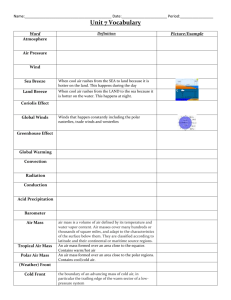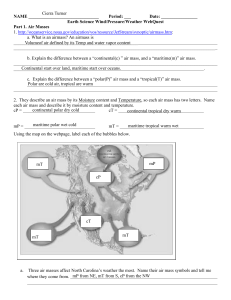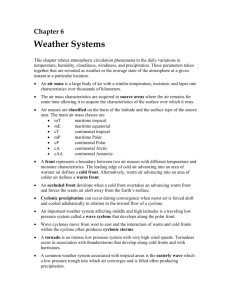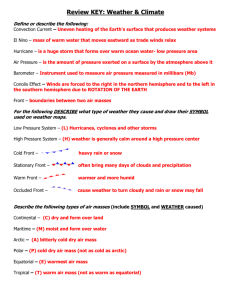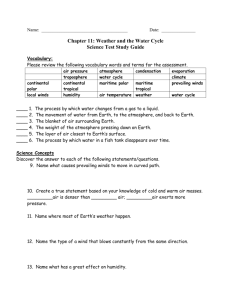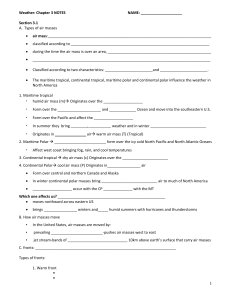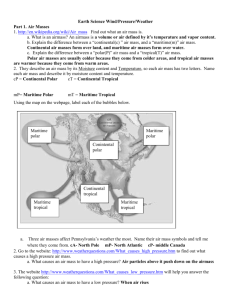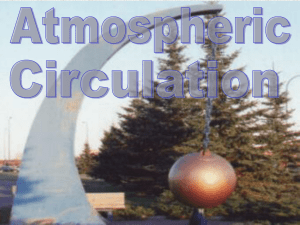Pressure, Wind and Weather Systems
advertisement
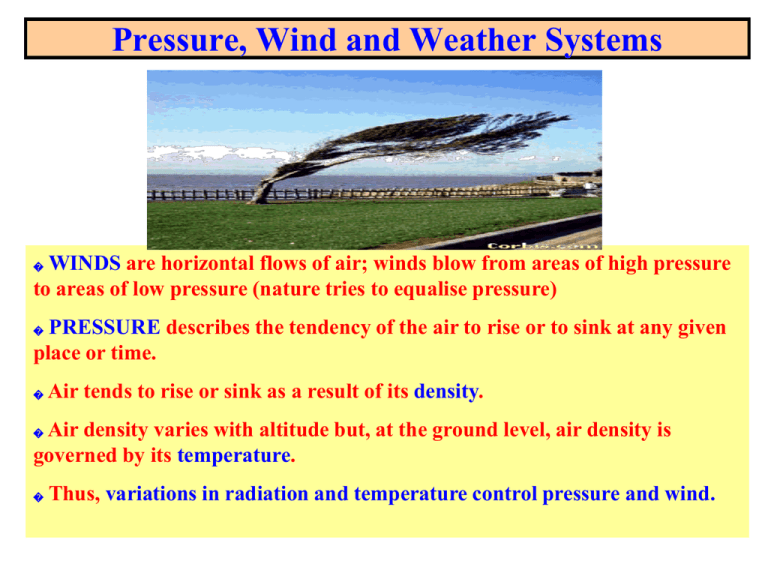
Pressure, Wind and Weather Systems WINDS are horizontal flows of air; winds blow from areas of high pressure to areas of low pressure (nature tries to equalise pressure) � PRESSURE describes the tendency of the air to rise or to sink at any given place or time. � � Air tends to rise or sink as a result of its density. Air density varies with altitude but, at the ground level, air density is governed by its temperature. � � Thus, variations in radiation and temperature control pressure and wind. Pressure & Wind Powerpoint Courtesy of: atschool.eduweb.co.uk This powerpoint has been altered by Mr. Smith! GLOBAL PRESSURE & WIND Global circulation depends on differential heating over the globe. The system is driven by strong equatorial heating, causing LOW PRESSURE. Equatorial air rises, diverges and descends over the tropics, where HIGH PRESSURE dominates; where it diverges at ground level. This tropical air blows towards the equator, completing the equatorial cell, or towards the mid-latitides where it meets cold, dense polar air blown out from the polar HIGH PRESSURE. These contrasting tropical and polar air masses meet at the POLAR FRONT LOW PRESSURE BELT, where the warmer air is forced upwards by the polar air. At high level, this air again diverges towards the pole or to the tropic. POLAR HIGH POLAR FRONT (LOW PRESSURE) TROPICAL HIGH EQUATORIAL (Inter-tropical convergence zone - ITCZ) LOW Wind strength depends on the difference in pressure between the high and low pressure systems, and the distance between them. � This is called the PRESSURE GRADIENT; it is a similar concept to the physical slope between two places, shown on a contour map. Pressure is shown by ISOBARS on a weather map. � Pressure difference essentially depends on the temperature difference between the two places. � A steep pressure gradient results from a large pressure difference or short distance between places and causes strong wind. WIND DIRECTION & STRENGTH Farmers plant trees to protect orchards, houses, stock or prevent soil erosion Locally, wind is channelled down streets (wind canyons). Strong winds also occur in low latitudes due to stronger heating and steeper presure gradients. Hurricanes and tornadoes are both tropical phenomena. Strong polar winds due to low friction Beach windbreaks reduce windspread by increasing friction Hurricane in Florida Tornado in USA High CORIOLIS FORCE Theoretical wind which would result solely from pressure gradient Actual wind which blows, as diverted by Coriolis Force Low Pressure gradient wind blows from high presure towards low pressure. � The earth’s rotation diverts this wind direction laterally. This force is called the CORIOLIS FORCE. � The Coriolis force diverts wind the the right in the northern hemisphere; to the left in the south. � The effect is stronger at high altitude where ground level friction is less significant. � LOW In the north, winds blow clockwise out from a high pressure. (In the south, they blow anti-clockwise). HIGH In the north, winds blow anticlockwise into a low pressure system. In the south, they blow clockwise. HIGH PRESSURE High Pressure means that air tends to sink. Sinking air is compressed, warms up as a result and its relative humidity falls below saturation. Any clouds evaporate. Rainfall is unlikely, apart from occasional short, intense convectional storms due to insolation with lack of clouds in daytime. LITTLE WIND CLEAR SKIES High pressure systems have clear skies, little or no wind, little rainfall and tend to be stable and slow moving. � Visibility is initially good, but rapidly deteriorates as dust is trapped by sinking air and is not washed out by rainfall. � Cloud cover is slight, resulting in a high diurnal ranges of temperature (hot days, cold nights). Due to the trapped dust particles and cold nights, dew, frost, fog or smog are common. � Air quality is low as all forms of pollution are retained in the lower atmosphere. � VISIBILITY IS POOR FEW CLOUDS CLEAR SKIES CAUSE FROST VISIBLITY REMAINS BETTER IN MOUNTAINS - LESS POLLUTION LOW-LATITUDE LOW PRESSURE SYSTEMS Low pressure systems involve air that tends to rise, thus causing clouds and precipitation. Those near the equator tend to be high energy due to strong ground heating (convectional). Low pressure systems may develop tornadoes and sometimes develop into hurricanes, fuelled by warm, very humid air evaporated from tropical oceans in summer. They tend to be fast moving, with plenty of cloud cover that reduces diurnal temperature range, strong winds and high rainfall. Hurricane off USA fueled by hot humid air over the Caribbean A convectional cumulo-nimbus cloud results from strong ground heating at the equator A tornado may develop from a cumulo-nimbus cloud WARM FRONTS A FRONT is the boundary between two air masses. A depression has two, a warm (the front of the warm air) and a cold. 1 TROPICAL MARITIME AIR POLAR MARITIME AIR 2 MAINLY STRATUS CLOUDS The warm front is angled gently due to ground level friction which slows the air at low level as the whole system moves eastwards. POLAR MARITIME COLD FRONTS TROPICAL MARITIME The cold front is steeper, also due to ground level friction slowing the lower air, so uplift is more rapid than along the warm front. � This causes cumulo-nimbus clouds and possible thunderstorms rather than thick stratus cloud. � Eventually, the two fronts meet, forcing the warm air off the ground. This is an OCCLUDED FRONT (occlusion), and happens to all depressions as they ‘fill’. � The whole system takes about 24 hours to pass. � OCCLUSION Tm air forced up Pm air meets at ground level
